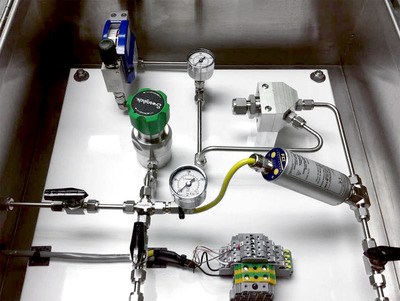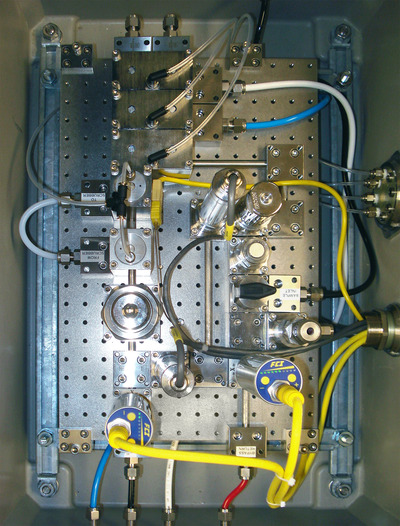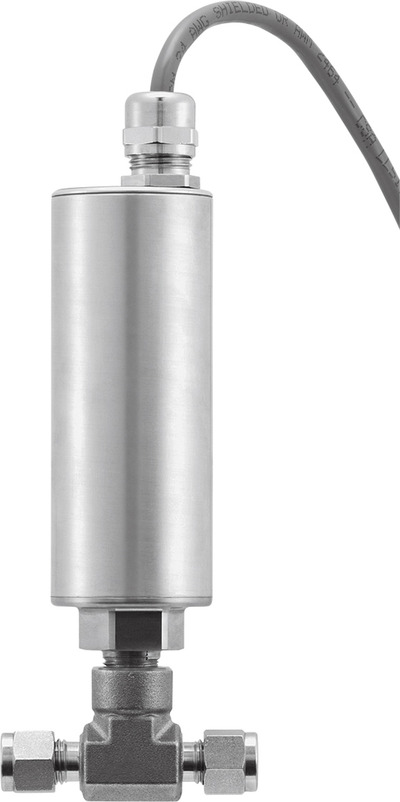Analyser sampling systems: verifying fluid flow for reliability and accuracy
By Sam Kresch, Product Manager, Fluid Components International (FCI)
Tuesday, 12 February, 2013
No matter how sophisticated a fluid analyser system may be, it will be ineffective if a sample flow fails to reach the analyser sensor or if the sample is contaminated or stale. The most advanced systems in the world cannot provide accurate results without a valid fluid sample.
Gas chromatographs, mass spectrometers, optical spectrometers and photometers are a few examples of analyser technologies applied in process and plant systems that need sample flow assurance. It is an accepted industry best practice that sampling systems have some type of flow monitor to assure valid samples and analysis.
Failing to monitor fluid flow to the analyser may result in contaminated product batches and discharging regulated substances. The costs of analyser failure are potentially huge in terms of affecting product materials, damage to equipment, regulatory fines, liability and more.
While there are a number of fluid flow monitoring technologies on the market, immersible thermal dispersion technology combined with packaging and sensor designs optimised for sampling systems has emerged as the new best-in-class technology. Thermal dispersion mass flow sensors have proven themselves for decades to be extremely reliable in other demanding process and plant applications - often in relatively close proximity to analyser systems.
Recent developments
The trend towards mounting the sample-handling system at the process has greatly enhanced process efficiency. Recent developments in packaging and speed now make it possible to run analyser systems more efficiently, utilising the real-time information to process online in batch mode. Developments in continuous flow reactors combine with analytics and new sampling systems to improve reaction times. More and more systems now provide analysis of the process in real time, making the integrity of the readings that much more important to the process success. The ideal flow monitor should provide the form, fit and functions that will accommodate both these new-generation analyser systems and traditional legacy and hybrid designs (Figure 1).

Depending on the analyser type, sampling fluid is often transported in 1/8″ to ½″ tubing. Most systems typically draw small samples in ¼″ tubes. Also growing in popularity are systems based on the industry-standard SP76 manifold. SP76 is an ANSI/ISA standard approved in 2002, which is supported and has been adopted worldwide by major chemical and refining companies (Figure 2).

SP76 and NeSSI basics
Leading the way for the SP76 standard is the New Sampling/Sensor Initiative (NeSSI) organisation, initially created in 1999 through discussions in a Center for Process Analytical Chemistry’s (CPAC) oil and petrochemical focus group. Other organisations have embraced and are promoting NeSSI/SP76, including the International Forum for Process Analytical Chemistry (IFPAC) and the Federation of Analytical Chemistry and Spectroscopy Societies (FACSS).
Each block of a typical SP76 train is 1.5 x 1.5″ square and effectively becomes a convenient plug-and-play modular surface-mount interface for numerous sampling system components (Figure 3). The NeSSI group remains active in advancing enhancements for the process analysis community. Beyond the initial physical interface of the SP76 manifold itself, the group has defined progressive levels of sophistication, known as Gen. I, II and III, that provide for digital bus communications, hazardous location approval types and the Sensor Actuator Manager (SAM).

Flow technologies
Regardless of the analyser fluid sampling system configuration, flow monitoring is essential to ensure proper analyser operation. There are numerous methods and technologies available to monitor sample flow on a real-time basis. These can be mechanical spring or gravity loaded pistons, variable area types, differential pressure and thermal mass flow.
In most cases, a simple relay contact or solid state output change is all that is desired to indicate a reduction or absence of flow at a predetermined setting. A recent trend is driving the output requirements to include an analog or digital communication signal to monitor the sample flow rate throughout the flow range. This allows operators to better predict flow declines due to disruptions caused by clogging filters, line contamination from fouling fluids, leaky or failing pumps, and other time and wear susceptible components in the system.
Mechanical devices normally have the advantage of not requiring power to operate; however, a minimum number of wires are still required to transmit an electronic signal (contact closure) back to the control system. As these devices are triggered by the force of the flow stream such that specific and fixed application details, including the sampled fluid’s density, viscosity, temperature, pressure, flow rate and, if non-adjustable type, the trip point, must be known and be specified when ordering them.
Furthermore, because springs, magnetic components and seals are all in the wetted flow stream, their material compatibility must also be evaluated by the specifying engineer. While mechanical devices with factory fixed trip points can be one of the lower priced solutions, those with adjustable trip points are often double the cost and approaching the price of some of the more robust and sophisticated technology solutions mentioned later.
The leading drawback and most frequent user issue with these mechanical devices is their susceptibility to sticking over time. As all mechanical designs have moving parts in the flow stream, contaminating fluids can be a serious source of future failure. Fouling contaminants can progressively build up over months or years and are only detected when other failures in the system are detected.
These devices can also have nooks and crannies that are exposed in the flow stream as they displace the flow path volume. In addition to being another area subject to clogging, they can trap previous samples or purge media which can contaminate subsequent samples. Piston-actuated devices also have no continuous visual indication of normal or abnormal flow conditions for the operator, other than their preset trip point.
Variable area meters
Variable area meters have the advantage of continuous visual display of flow; however, they are also susceptible to sticking over time in many fluids. Their longer term reliability is often a concern expressed by analyser users. Adding a magnetic pickup to provide an electronic relay trip or an analog output adds significantly to their cost. Variable area meters tend to take up more valuable enclosure space than desired as they are very orientation dependent; and their flow input and output access are typically on different planes.
Differential pressure (DP) devices can be a sound technology to monitor analyser flow rates. Even in the small line sizes and at very low flow rates associated with analyser sampling systems, a properly sized orifice and sensitive pressure transducer can yield desirable results. The two main disadvantages of DP technology are:
- Its limited flow rate turndown capability.
- The large errors incurred at the low end of the flow rate readings.
Very often it is the low end that is critical for sample flow assurance and flow monitoring in analysers and sampling systems. Unfortunately, optimising the flow range to the low end of DP sensors can result in an appreciable pressure drop and poor flow measurement performance at normal flows.
Similar to piston-driven switches and variable area meters, DP flow monitors must be selected knowing the density and a specifically narrow flow rate range of the sample process. There are limited DP devices designed for the SP76 manifold. They require at least two block spaces and are the most expensive of all the monitoring devices.
Solving the problems
An ideal flow monitor for an analyser sampling system would be one that can be adapted on site and adjusted specifically in the application. In addition, a more robust flow sensing technology married to flexible and user programmable electronics, which can be specified without detailed and finite validation of process variables such as density, viscosity, flow range, fluid type, etc, also would alleviate a pain point for the analyser system supplier and site engineering team.
Flow monitors designed with thermal dispersion technology match up extremely well with the ideal universal use criteria to support an analyser sampling system. Depending on the manufacturer’s flow element and electronics design, they can be set up by the user in situ to assure the field engineer a successful, first time correct installation. These devices may be configured in the field to operate in gases or liquids at almost any density or viscosity with no special consideration at time of ordering.
There are two major types of thermal devices on the market. One type utilises a capillary bypass technique and is better known as a mass flow controller or MFC. MFCs divert a portion of the main flow into a small bypass and sense the heat transfer of flowing fluid in the bypass channel. This technique can be very effective; however, the capillary tube is highly susceptible to contamination and clogging and should only be considered for use with clean or pre-filtered fluids. Capillary bypass flow monitors are generally applied in lab use, and agency approvals (eg, FM, CSA, ATEX, IECEx, etc) for use in hazardous, explosive environments are rare. Flow range selection is also important when specifying MFC type flow monitors.
Immersible thermal dispersion technology
The other type of thermal dispersion flow monitoring device is one that uses thermowells in the flow stream, sometimes referred to as immersible-type. These types of devices typically apply heat to one thermal sensor relative to a second thermal sensor measuring the process temperature. The temperature difference changes with flow rate. In the case of gases, the measurement is directly related to mass flow. Immersible thermal flow monitors are very effective over wide flow ranges in gases and over smaller low flow ranges in liquids.
Thermal technology is particularly advantageous in process analyser systems because it has no moving parts to wear, stick or foul. With their tiny thermowells and wetted materials typically made of 316L stainless steel or Hastelloy alloys, they are highly compatible and well suited to application in most analysers and sampling systems.
The thermal probe can be threaded into industry-standard tube tee branches (eg, Parker, Swagelok, Circor) (Figure 4) or even into a single block in the previously mentioned SP76 manifold, resulting in minimal dead space. There are no cavities to trap previous samples so sample integrity is always the highest. Another key characteristic of thermal flow monitors for analyser applications is their superior sensitivity to low flow rates.

It is not uncommon to find analysers requiring preheated or hot process fluids. As thermal devices typically do not require elastomer seals, and can be easily configured with the sensor element and electronics separated (remote), they are often the best and only solution for higher temperature service requirements - up to 260°C is common. Other features may include indicators or displays of trip point status and flow rates, isolated SPDT alarm contact and analog or digital output to monitor flow trends.
Perhaps the most important benefit of some types of thermal devices is their ability to be field set and field adapted by the user for inexact, unknown or changed process and application conditions. Precisely and completely defined process conditions and fluid variables are often lacking during the preliminary design and engineering phase. Variations in tubing configuration, flow direction layout, ambient and fluid temperature conditions, pressure and density variations, viscosity, flow range, fluid type and trip points are variables that are often only finally determined after installation and site commissioning. Thermal dispersion flow technology-based products with smart electronics can provide maximum field adjustability and site adaptability.
Conclusions
Flow sensors and monitors are just one of the components required in complex process analyser and sampling systems. While there are several flow monitoring technologies available that can be considered, their diversity can make proper selection a major challenge. The question becomes, which flow technology is optimum for the particular type of analyser application and its operating environment?
Properly selecting a flow sensor for an analyser sampling system can take an inordinate amount of an engineer’s time because of the complex factors that must be reviewed. Consideration must be given to:
- diversity in measuring range
- fluid type and condition compatibility
- temperature and pressure condition suitability
- outputs and user interfaces
- approvals for Ex locations
- site adaptability and adjustability
- tube tee and SP76 compatibility
- dimensions, weight and orientation
- total installed cost
Even then there is still worry about whether or how well the chosen flow monitor really functions when the system is commissioned, launched and put into operation. A flow monitor that is adaptable and can be site set for almost any field condition variables, such as those based on immersible thermal dispersion technology, provides maximum confidence that the analyser system will perform as expected upon installation.
Thermal mass flowmeters: when is pressure compensation important?
The claim that thermal mass flowmetering is independent of pressure is only half of the truth.
Automating water management for improved mining sustainability
Water is fast becoming a precious commodity, and mine water management has shifted from an...
Ultrasonic and radar level technologies: bringing clarity to the water and wastewater industry
There is room for both ultrasonic and radar level measurement technologies in the water and...








